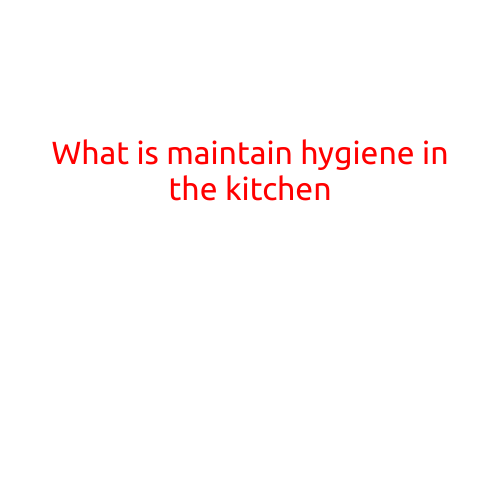
What is Maintaining Hygiene in the Kitchen?
Maintaining hygiene in the kitchen is crucial for the health and well-being of the people who cook and eat in your home. Kitchen hygiene is not just about cleanliness, but also about following proper food handling practices to prevent the risk of foodborne illnesses. In this article, we will discuss the importance of maintaining hygiene in the kitchen and provide some tips on how to do it effectively.
Why is Kitchen Hygiene Important?
Foodborne illnesses can be caused by bacteria, viruses, and parasites that contaminate food, surfaces, and equipment in the kitchen. According to the World Health Organization (WHO), every year, an estimated 420 million people worldwide suffer from food poisoning, which results in approximately 125,000 deaths. Maintaining hygiene in the kitchen is essential to prevent the spread of these illnesses and keep your loved ones safe.
How to Maintain Hygiene in the Kitchen
- Cleanliness is Key
Cleanliness is the foundation of kitchen hygiene. Make sure to wipe down all surfaces, including countertops, sinks, and refrigerators, regularly. Use a mixture of soap and water to clean surfaces, and sanitize high-touch areas like door handles and faucets using a disinfectant.
- Wash Your Hands
Washing your hands is one of the most important habits to adopt in the kitchen. Use warm water and soap to wash your hands for at least 20 seconds before and after handling food, cleaning, and using the bathroom.
- Separate Raw and Cooked Foods
Raw and cooked foods should be stored and handled separately to prevent cross-contamination. Use separate cutting boards, utensils, and plates for raw and cooked foods.
- Label and Date Leftovers
Label and date leftovers to ensure they are consumed within a safe time frame. Use airtight containers to store leftovers and refrigerate or freeze them promptly.
- Store Food Safely
Properly store food to prevent bacterial growth. Keep raw meat, poultry, and seafood in sealed containers and at the bottom of the refrigerator compartment.
- Clean and Sanitize Equipment
Clean and sanitize equipment, such as dishwashers, microwaves, and refrigerators, regularly. Check user manuals for specific cleaning instructions.
- Wash Fruits and Vegetables
Wash fruits and vegetables under running water to remove dirt, bacteria, and pesticides. Gently scrub firm fruits and vegetables with a brush or soft cloth.
- Don’t Let Pests Infest Your Kitchen
Keep your kitchen pest-free by storing food in sealed containers, taking out the trash regularly, and repairing any cracks or holes in walls and floors.
Conclusion
Maintaining hygiene in the kitchen is crucial for the health and well-being of everyone who cooks and eats in your home. By following these simple tips, you can reduce the risk of foodborne illnesses and ensure a safe and healthy food environment. Remember, cleanliness, hand washing, separation of raw and cooked foods, proper storage, and equipment sanitation are essential habits to adopt in your kitchen.





